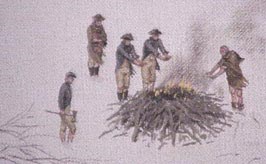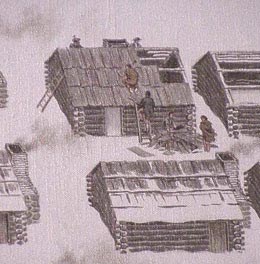
Visitor Center mural Why is Valley Forge so famous when the 1779-1780 Morristown encampment had the worst winter of the 18th century? Probably because more soldiers died during the Valley Forge encampment. It is estimated that between one to three thousand soldiers died during the Valley Forge encampment while only about one hundred died at Morristown’s 1779-1780 encampment. While most people think the 1777-1778 Valley Forge encampment had a bad winter, in reality it was just an average winter. The following winter at Middlebrook [1778-1779] was mild. Weather historians agree that the Morristown winter of 1779-1780 was the worst winter of the 18th century. It wasn’t the weather that was the problem at Valley Forge; it was the army’s inexperience. For most of the soldiers at Valley Forge it was their first winter camp with the army. The camp and hut construction wasn’t up to the standards later used at Morristown. The men lived in damp conditions and did not properly take care of camp sanitation. As a result many men sickened and died.
By the winter of 1779-1780, however, most of the soldiers were veterans and had grown accustomed to the harsh military life. They knew how to properly set up a winter camp and most had been inoculated against smallpox. Consequently, though the men suffered through a harsh winter and lacked proper food and clothing, they were able to survive. Why did the Continental Army camp at Morristown? The Continental Army camped in the Morristown area on several occasions because of its location and resources. Morristown was a two day march from the main British base in New York City. The Watchung Mountains and the Great Swamp stand between New York and Morristown and acted as a natural defensive work. As a result, Morristown could not be taken by a surprise attack. The various roads passing through Morristown allowed the army to move in any direction to counter the movements of the British. Because of its roads and safe location, Morristown served as a military supply depot for much of the war.

Visitor Center mural Are the huts original? None of the huts displayed in the park go back to the Revolutionary War. What happened to the original huts? The huts constructed by the Continental Army were either torn down by the local farmers for their own use or they eventually fell apart over time. Farmers who had lost huge amounts of timber due to the encampment wanted the huts for their boards, nails and wood that could be used for construction, fencing or fuel. The huts were originally meant to be used just for the winter of 1779-1780. However, some huts were used as a hospital after the army left in June 1780. |
Last updated: March 31, 2012
